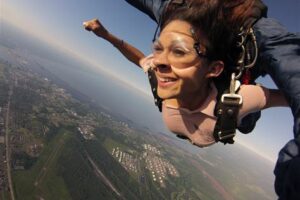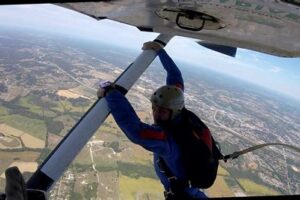Table of Contents
Have you ever wondered how quickly you descend when skydiving? Discover the exhilarating experience of freefall and learn about the speed at which you plunge towards the earth during this thrilling adventure. Prepare to be amazed by the incredible velocity and adrenaline rush that skydiving offers!
Have you ever wondered what it feels like to defy gravity and experience the exhilarating thrill of freefalling through the sky? Skydiving offers adrenaline junkies a unique opportunity to embrace their inner daredevil and push their limits. One of the most common questions that arise when considering this extreme sport is, How fast do you actually fall when skydiving? Well, brace yourself for an epic adventure as we explore the physics behind this heart-pounding activity.
The Thrill of Skydiving
Skydiving is an exhilarating adventure sport that offers a unique adrenaline rush and breathtaking views. The feeling of soaring through the sky, defying gravity, and experiencing a momentary sense of weightlessness is an unmatched experience. As you dive out of an aircraft, you might wonder how fast you will fall. In this article, we will explore the factors that determine your speed during a skydive.
The Role of Gravity
When you jump from an aircraft, the primary force that influences your descent is gravity. Gravity is the natural phenomenon that pulls objects towards the Earth’s center. It is responsible for giving skydivers the sensation of falling. The acceleration due to gravity is approximately 9.8 meters per second squared (32 feet per second squared).
Terminal Velocity: The Maximum Speed
As you begin your freefall, you will accelerate due to gravity. However, after a certain point, the force of air resistance or drag will balance out with gravity, causing you to reach terminal velocity. Terminal velocity is the maximum speed at which a falling object can travel when the upward force of air resistance equals the downward force of gravity.
Achieving Terminal Velocity
Several factors influence how quickly you reach terminal velocity during a skydive. These include your body position, weight, and the surface area of your body that is exposed to the air. Typically, a stable belly-to-earth position with arms and legs slightly extended allows for the quickest acceleration towards terminal velocity. Skydivers in this position can reach speeds of around 120 miles per hour (193 kilometers per hour).
Freefall Duration
The duration of your freefall depends on the altitude from which you jump and the speed at which you fall. Generally, skydivers exit the aircraft at an altitude of 10,000 to 14,000 feet (3,048 to 4,267 meters) above the ground. From this height, it takes approximately 60 seconds to reach the ground during a typical skydive. However, this time may vary depending on weather conditions, body position, and other factors.
Factors Affecting Speed
While gravity is the primary force influencing your speed during a skydive, several factors can affect your descent rate. These include:
- Body Position: A stable and aerodynamic body position allows for faster speeds.
- Weight: Heavier individuals experience a faster descent rate due to increased gravitational pull.
- Equipment: The size and design of the parachute and jumpsuit can impact speed.
- Altitude: Higher altitudes provide more time for acceleration and reaching terminal velocity.
- Wind Conditions: Strong winds can either increase or decrease your descent speed.
Acceleration and Deceleration
During a skydive, you experience both acceleration and deceleration. Initially, as you jump from the aircraft, you accelerate due to gravity. As you approach terminal velocity, your acceleration decreases until you reach a constant speed. When you deploy your parachute, you then experience a rapid deceleration as the drag increases, slowing down your descent.
Enjoying the Experience
While understanding the science behind your fall speed can be fascinating, the primary focus of your skydive should be on enjoying the experience and embracing the thrill. The feeling of weightlessness and the rush of adrenaline are what make skydiving an unforgettable adventure.
Conclusion
Skydiving offers an incredible opportunity to experience the sensation of freefalling through the sky. Your speed during a skydive is influenced by gravity, body position, weight, equipment, altitude, and wind conditions. Reaching terminal velocity allows you to experience the maximum speed during your freefall. However, regardless of the speed, the true essence of skydiving lies in the exhilaration, stunning views, and the pure joy of defying gravity.
Introduction:
When it comes to experiencing the ultimate adrenaline rush, few activities can match the thrill of skydiving. As you gracefully plunge from an airplane, you might wonder just how fast you’re hurtling towards the ground. Understanding the speed at which you fall while skydiving can add another layer of excitement to your already exhilarating adventure. So, let’s dive into the world of skydiving speeds to satisfy your curiosity.
1. Terminal Velocity: The Name of the Game
Skydivers achieve what is known as terminal velocity once they fall for a certain amount of time. Terminal velocity occurs when the force of gravity pulling the skydiver downward becomes equal to the force of air resistance pushing upward. On average, a skydiver reaches terminal velocity around 120 mph (193 km/h).
2. Acceleration: Going from 0 to 120 mph
During the initial seconds of a skydive, divers experience rapid acceleration as they overcome the drag caused by the weight of their bodies. This acceleration allows the diver to gain speed quickly, going from 0 to 120 mph in just a matter of moments.
3. Factors Affecting Speed
Although terminal velocity is typically around 120 mph, there are various factors that can influence the speed at which a skydiver falls. These factors include body position, weight, altitude, and freefall time. By altering body orientation or adjusting equipment, experienced skydivers can manipulate the speed at which they fall.
4. Becoming a Human Bullet: The Belly Position
For beginners, the most common body position during a skydive is the belly-to-earth position. This position offers stability and control while allowing skydivers to better gauge their speed and surroundings. Falling in the belly position is comparable to being a ‘human bullet’ as the skydiver zooms through the air.
5. Getting Speedy with the Head-down Position
For more experienced skydivers seeking a faster fall, the head-down position is utilized. By pointing their head towards the ground and spreading their arms and legs, the diver reduces air resistance, allowing for increased speed. Falling in a head-down position can result in an even greater sense of speed and exhilaration.
6. The Influence of Altitude
As skydivers gain altitude, the thinner atmosphere results in less air resistance, allowing them to fall faster. However, it’s important to note that at higher altitudes, divers have more freefall time, allowing them to reach terminal velocity eventually regardless of the altitude.
7. Weight Matters: The Role of Mass
Although weight may not be a major factor for some activities, in skydiving it significantly impacts fall speed. Heavier individuals will generally fall faster due to the increased force of gravity acting on their larger mass. However, this effect is more noticeable in solo skydiving compared to tandem jumps.
8. Enjoy the Ride
While knowing how fast you fall when skydiving can enhance your understanding of the experience, the true beauty lies in the thrill of the descent itself. Whether you’re accelerating at breakneck speeds or cruising through the sky, skydiving offers an unforgettable rush that words can’t fully capture. So, strap in and enjoy the ride as you plummet towards the earth with a smile on your face.
Point of View: Professional
When it comes to the exhilarating experience of skydiving, one of the most commonly asked questions is: How fast do you fall? As a professional in the field of skydiving, I am here to provide you with accurate information about the speed at which you descend during this adrenaline-pumping adventure.
1. Terminal Velocity:
During a skydive, the speed at which you fall is determined by a crucial concept known as terminal velocity. Terminal velocity refers to the maximum speed an object can reach when falling through the air, where the force of gravity pulling the object down is balanced by the upward resistance of air. For a human body in a belly-to-earth position, the approximate terminal velocity is around 120 miles per hour or 193 kilometers per hour.
2. Freefall Speed:
During the initial stages of a skydive, when you jump out of the aircraft and are in freefall, your speed will gradually increase until you reach terminal velocity. The acceleration due to gravity causes your velocity to steadily rise until the resistance from the surrounding air matches the force of gravity, resulting in a constant and maximum speed. This process generally takes around 10-12 seconds before leveling off.
3. Factors Affecting Speed:
Various factors can influence the speed at which you fall during a skydive. These include your body position, weight, altitude, and any additional equipment you may be carrying. By adjusting your body posture, such as arching your back and extending your limbs, you can alter your drag coefficient and potentially increase or decrease your speed to some extent.
4. Sensation of Speed:
It’s important to note that while skydiving at speeds of up to 120 miles per hour may sound daunting, the actual sensation of speed during the experience can be quite different. Due to the lack of reference points and the feeling of floating in the vastness of the sky, the perception of speed might not be as intense as one would expect. Instead, the focus often shifts to the breathtaking views and the unique feeling of freedom.
In conclusion, as a professional in the field of skydiving, I can confidently state that the speed at which you fall during a skydive is determined by terminal velocity, which typically reaches around 120 miles per hour. By understanding the concept of terminal velocity and considering various factors that affect speed, one can better appreciate the thrilling and controlled nature of this extreme sport. So, if you are ready for an unforgettable adventure, don’t hesitate to take the plunge and experience the incredible sensation of skydiving firsthand.
Thank you for taking the time to visit our blog and read our article on the thrilling experience of skydiving. We hope that you found it informative and engaging, and that it has sparked your curiosity about the speed at which one falls during this exhilarating activity. In this closing message, we will summarize the key points discussed in the article and encourage you to explore further if you are interested in learning more.
As we delved into the topic of how fast one falls when skydiving, we discovered that several factors come into play. The initial speed of a skydiver depends on various elements such as body position, weight, and altitude. Transitioning from a belly-to-earth position to a head-first freefall can significantly increase the speed, allowing experienced skydivers to reach velocities of up to 120 miles per hour. However, it is important to note that these speeds are typically achieved by seasoned professionals and not beginner skydivers.
We also explored the concept of terminal velocity, which refers to the point at which the force of gravity pulling the skydiver downward is balanced by the resistance of the surrounding air. At this point, the skydiver’s speed stabilizes, creating a sensation of floating rather than falling. Terminal velocity is typically reached after around 12 seconds of freefalling, at speeds of approximately 53 meters per second (about 120 miles per hour). Understanding terminal velocity is crucial not only for skydivers but also for engineers and scientists studying fluid dynamics.
In conclusion, the speed at which one falls when skydiving is influenced by various factors and can reach incredible velocities. It is a thrilling experience that combines the adrenaline rush of extreme sports with the breathtaking beauty of the aerial landscape. Whether you are an aspiring skydiver or simply someone with a sense of adventure, we hope that this article has provided you with valuable insights into the physics and excitement of skydiving. If you wish to learn more about this fascinating topic or are considering taking the plunge yourself, we encourage you to explore reputable skydiving schools and trusted sources for further information and guidance.
Once again, thank you for visiting our blog, and we hope to see you back soon for more exciting articles and discussions!
.
How Fast Do You Fall When Skydiving?
When it comes to skydiving, one of the most common questions people have is about the speed at which they will fall. Here are some frequently asked questions and their answers regarding the speed of falling during a skydive:
-
How fast do you fall when skydiving?
During a typical skydive, a person can reach speeds of around 120 miles per hour (193 kilometers per hour) in freefall. This speed is achieved due to the force of gravity pulling the skydiver towards the ground.
-
Why do you fall so fast in skydiving?
The speed at which you fall during skydiving is determined by your body’s weight and the surface area you present to the air. Since skydivers adopt a spread-eagle position, their bodies encounter less air resistance, allowing them to reach higher speeds compared to other positions.
-
Can you control your speed while skydiving?
While you cannot directly control your falling speed during a skydive, you can influence it to an extent by adjusting your body position. By arching your back and lifting your legs slightly, you can increase air resistance and slow down your descent. Conversely, straightening your body can reduce air resistance and increase your speed.
-
How long does the freefall last?
The duration of the freefall depends on various factors, including the altitude from which you jump. Typically, a skydive involves approximately 60 seconds of freefall before the parachute is deployed. However, advanced skydivers may engage in longer freefall experiences depending on their training and preferences.
-
Is freefalling during skydiving safe?
When performed under proper supervision and adherence to safety guidelines, freefalling during skydiving is generally considered safe. Skydiving centers prioritize safety measures, equipment checks, and certified instructors to ensure a secure experience for every participant.
Remember, these answers provide a general understanding of the speed and mechanics of falling during a skydive. It is always recommended to consult with professionals at a reputable skydiving facility for accurate and detailed information specific to your skydiving experience.






